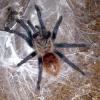I recently got a colony of Solenopsis xyloni and I've noticed that the workers were attracted to a side of the enclosure that a desk lamp is on. I decided to move the lamp around the enclosure and I noticed that the ants would more or less coagulate on the side it was shining on. I was under the impression that ants were photophobic and would run from light. Has anyone got a reason for this?
- Formiculture.com
- Forums
- Gallery
- Members
- Member Map
- Chat






















